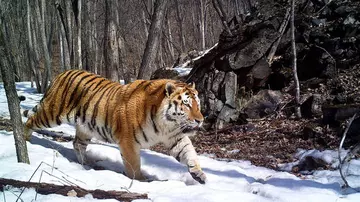
In Conserving Tiger Food Chains students will be transported to the depths of Siberia to become ZSL scientists at our fantastic Tiger Falls enclosure. Tracking is a vital tool used in the conservation of species and in Conserving Tiger Food Chains; students will get the opportunity to learn the techniques used by ZSL scientists to track animals in the wild. Using real camera traps and data collected in the wild, students will work in small teams to decipher the movements of the animals and identify different individuals photographed on the camera traps. They will also get the opportunity to learn about what ZSL is doing to protect these fascinating creatures in the wild.
This session takes place outdoors – please ensure appropriate clothing is worn.
| Age: KS2 (7-11 years) | Duration: 45 minutes | Capacity: 35 students | Outdoor Session |

Linda Kerley and ZSL
Amur tiger in a ZSL camera trap
Intended learning outcomes:
Students will be able to:
- Define the term ‘endangered’.
- Describe how changes in an environment can pose dangers to living things.
- Describe how ZSL scientists gather data on an endangered species.
National Curriculum links:
| KS2 Science | Working Scientifically |
|
| Living things and their habitats |
|
|
| Animals, including humans |
|
|
| KS2 English | Reading-word reading |
|
| KS2 Geography | Locational Knowledge |
|
